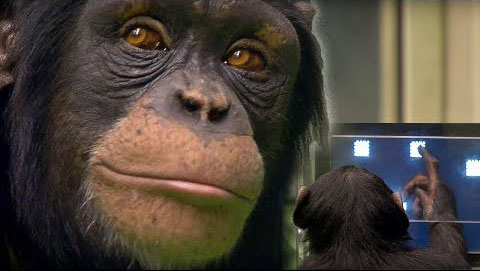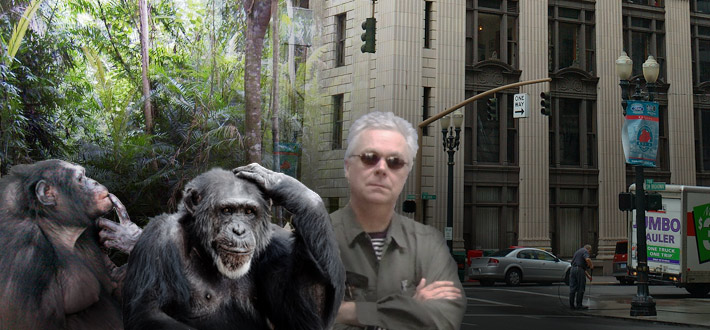
Bonobos and Chimpanzees: Human Traits in Our Nearest Relatives
All animals adapt, develop and diversify over time to ensure their species’ survival, so it’s not surprising that we share characteristics with our nearest relatives. Some of these are less well known, and quite surprising.
1. Self-recognition
Joshua Plotnik, a graduate student in psychology at Emory University in Atlanta, Georgia, recently observed this ability in elephants; it has also been observed in dolphins and apes: gorillas, orangutans, chimpanzees and bonobos all show this ability. According to Plotnik, mirror self-recognition is a trait only known among animals that are thought to lead highly complex social lives, which may require a sense of self-awareness and the display of emotions like empathy. “Recognition of the self may allow you to take yourself out of the picture and see yourself as separate from others,” he explains. Like us, these animals recognize similarities between themselves and others, can tell one individual from another, recognizing friend from foe. Chimpanzees can remember a face for over a decade. However, unlike us, fMRI data suggests that apes do not engage in self-reflection or introspective contemplation, and have only a rudimentary sense of self.
2. Group behavior
So many different animal species survive as groups: from bees to fish, from birds to dogs, from elephants to apes, to ourselves. Quite obviously there is safety in numbers. Most primates, including humans, but excluding orangutans, spend their lives in large social groups or communities. To survive as a group each species has evolved its own strategies and we’ve mentioned some of these with regard to bonobos and chimps.
As primatologist Frans de Waal points out, “One can’t reap the benefits of group life without contributing to it. Every social animal strikes its own balance between the two. Some are relatively nasty, others relatively nice. But even the harshest societies, such as those of baboons and macaques, limit internal strife. People often imagine that in nature weakness automatically means elimination – a principle hyped as the ‘law of the jungle’ – but in reality social animals enjoy considerable tolerance and support. Otherwise, what would be the point of living together?”
Apes and humans are born immature – humans are born with only 25% of our brain developed, apes with 50% – so although apes remain immature for a much shorter time than we do, the early environment of apes and ourselves is crucial for development. The more brain development that takes place in the world, the more adaptive the animal is. Like us, but to a more limited extent, apes are able to adapt to different environments, live in different areas and conditions, and develop different strategies for survival. Like us, they are acutely aware of their social environment: they ponder the options in front of them and decide what to do dependent on the circumstances.
Both chimps and bonobos form bonds, first between mother and child, but primates also form friendships within the community, which they express in grooming, traveling together, and defending each other. Cooperation and sharing are vital for group survival, so it is not surprising that many animals including wolves, whales and primates all display these qualities. For example, any chimp that finds food first owns it, no matter what his or her rank is in the hierarchy, and that ownership is respected by all group members. But sharing with family and friends is important: no one in the group goes without.
Brian Hare and colleagues at Duke University found in their study that young captive bonobos prefer sharing their food to eating alone, and, unlike human toddlers, will do so even with complete strangers. In a later study of wild-born bonobos at the Lola ya Bonobo sanctuary in the Democratic Republic of the Congo, the team found that bonobos will help a stranger get food without being asked, even when there’s no immediate payoff. Reports Hare, “We found that the test subjects preferred to voluntarily open the recipient’s door to allow them to share highly desirable food that they could have easily eaten alone – with no signs of aggression, frustration, or change in the speed or rate of sharing across trials. This stable sharing pattern was particularly striking since in other, non-sharing contexts, bonobos are averse to food loss and adjust to minimize such losses.”
Behavior towards those outside the group varies with circumstances in both our own and ape communities. Aloofness towards outsiders is often seen in non-human primate communities, probably because it helps to keep limited local food resources within the group. Chimp groups live within territories which have distinct boundaries patrolled by male groups. Chimpanzee raids include violence against neighbors and even killing. But when chimpanzees from different troops come together, there is often an exciting, friendly encounter, which lasts several hours, after which time some of the adult females are likely to switch groups seemingly in order to find different mates. Maintaining peace is important, and each species follows its own reconciliation protocol. Says de Waal, “Golden monkeys do it with hand-holding, chimpanzees with a kiss on the mouth, bonobos with sex, and tonkean macaques with clasping and lipsmacking.”
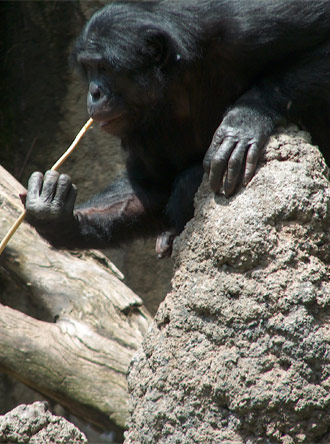
3. Tool Makers and Users
Apes are elementary tool makers and users. Chimpanzees will use their teeth or hands to obtain, shape and size twigs and branches for multiple uses. They might use them as sticks or clubs, for dipping into a nest to obtain ants, for bee killing and honey fishing, or for brain, eye and bone marrow eating. They will pound nuts with clubs or stones to extract kernels and have been seen using leaves as cleaning tools. Bonobos, in captivity at least, have been seen making flake tools to use for chopping, drilling, digging and unearthing food.
4. Learning
Like chimps and bonobos, we are predisposed to learn from members of our group who are older or of higher social status. Like our ape ancestors, we start by imitating those with whom we have the closest bonds: our mothers and caregivers. Both chimps and bonobos are goal-oriented, just like us. The activation of mirror neurons in the brains of chimps and bonobos facilitate learning by imitation.
Researchers found a notable difference between chimp and children’s learning behavior once an instructor was in the picture. In a now famous study, while both children and chimps were able to assess which steps were necessary and which were not in order to achieve a goal, chimps only copied the instructor’s relevant actions while human children tended to copy every action, including all the obviously unnecessary ones. Imitation is vital to humans: because of it we are able to learn languages, adopt cultural behaviors and acquire thousands of skills and customs. But our own mirror system is considerably more complex. For us the ability to emulate – to develop, adapt and change what we learn through imitation – is key to our advancement.
Says psychologist Thomas Suddendorf, “Though the chimpanzees in this experiment acted more efficiently and arguably more rationally, it is the children’s over-imitation that is crucial for faithful transmission of cultural knowledge and for accumulation.”
Chimps restrict their focus to the specific task and goal, so have little and probably no cumulative development in their society. From the children’s behavior in this experiment we can see that we are not only able to imitate, remember and perform an action, we are also set up to learn and codify our actions, and can edit, modify and build upon them. No ape could come up with the experiment to study this!
No matter how smart the human child is, he/she will be influenced by how someone older and supposedly smarter performs an action. The notion of a right way and a wrong way to perform a task is human; it involves waiting and trusting to see how to do it. Apart from ourselves, there is limited evidence of teaching in the animal kingdom. Chimpanzees have been observed to learn preferentially from high-status individuals. A “teacher” ape will modify his or her behavior in the presence of a “pupil” to foster learning in the pupil. Beyond that, since apes lack our sophisticated cognitive capacities: foresight, a fully-developed theory of mind, flexibility, etc., a more structured learning situation, which we take for granted, is impossible.
Interestingly, it is only from a recent study, published in Science October 2016, by scientists at the Max Planck Institute for Evolutionary Anthropology, that apes’ ability for even a nascent theory of mind was thought possible. In this study scientists recorded the eye movements of three great ape species, bonobos, chimpanzees and orangutans, while the animals watched videos of a man searching for a hidden object that had been moved without his knowledge. Surprisingly, they found that the apes looked more frequently at the location where the man expected the object to be (a belief the apes knew was false), even though the object was no longer there. This, and similar studies they held, suggest that apes do have at least a basic understanding of false belief, and an ability to intuit what another individual is thinking. Until now, understanding others so as to be able to predict their behavior, known as theory of mind, was thought to be solely a human characteristic. As de Waal says, the study “is a genuine breakthrough, not only because it avoids an undue reliance on language skills required to understand narrative and questions in theory of mind testing in children, but also because it highlights the mental continuity between great apes and humans.”
To establish unequivocally that great apes can think about things other than what they directly perceive, stronger evidence is needed. Yet they do have some idea of the world they live in. Like human two-year-olds, but unlike other primates, great apes have demonstrated that they can repeatedly think about things they did not perceive, passing up to and including stage five of Piaget’s object permanence. Anecdotes of chimps pretending or playing out an action – feeding a log “baby,” or distracting another chimp by an act of pretense – have been noted, so this does raise the possibility that our closest animal relatives have some ability to entertain alternative worlds in their minds. Says Suddendorf, “The comparative evidence suggests that great apes share this basic capacity to mentally go beyond the here and now, although the extent to which they can do this may well be limited in various ways.”
Apes’ inferences are tied to causal reasoning: “if this happens then that will happen,” or the negative. They can deduce that food is in the container that makes a noise when you shake it and not in the one that makes no noise. But they cannot generalize and have no ability for abstract thought. They can observe and imitate what other apes are doing; they may well follow your eye movements to see what you are looking at and will react to what you are seeing if it is relevant to them, but they do not wonder why.
5. Language
All animals need to have a way to transfer information reliably between members of their species, and they have therefore evolved acoustic, haptic (touch-based), visual, and chemical ways of communicating. Gestures such as pointing and the elementary sounds our early ancestors made to communicate are both actions performed for another’s interest and benefit. They were the basic building blocks of language, which itself became the foundation for human cooperation. Unlike dogs – humans have been living with dogs for about 15,000 years – chimps don’t understand what we mean by pointing or trying to communicate through gesture. Of course, apes do communicate with each other at a very basic level to express excitement or fear, for example, and studies have confirmed that monkeys tend to react differently and appropriately to alarm calls for a specific animal – the approach of an eagle versus a leopard for example. “Ape language” studies confirm some significant, though limited, understanding of symbols.

Bonobos such as Kanzi indicate that early and constant exposure impacts language development. Kanzi can point to what is offered to him in a lexigram board which represents 400 English words, nouns like ball or carrot; verbs like want and drink, and abstract words like tomorrow and yesterday. In contrast, humans speak over 6,000 different languages and some use sign language as well. Language works because we can use symbols and agree that a set of symbols means the same thing to all of us. It allows us to exchange thought and, unlike our ape ancestors, we are motivated to do this: we want to know what others are thinking; we want to know what they know, and how they know it, and we want to express our past experiences and future plans. While they are not by any means mathematicians, apes do have basic quantitative skills: they can tell large from small quantities and the difference between 2 and 3. They can also remember if there is more of something in one place than another.
6. Memory
Many animals hoard food for the winter without necessarily understanding why they do it. Young squirrels, for instance, will hoard nuts even if they have never experienced a winter. According to Suddendorf, these behavioral solutions to recurring seasonal changes may not be all that different from physical adaptations to the same problem – such as storing food for winter in body fat. “Although it is safe to conclude that animals have procedural and semantic memory systems, there is no obvious demonstration that they have episodic memory. Rats appear to use their hippocampus to create cognitive maps of their environment. Most species, even insects, demonstrate sophisticated navigational skills. But do they mentally reconstruct the particular events that shaped their knowledge? Do they reminisce about days of yore?”
The primatologist Tetsuro Matsuzawa has worked with chimps in confinement and in the wild for over three decades; through cognitive tests he concluded that chimps have extraordinary memories. “They can grasp things at a glance. As a human, you can do things to improve your memory, but you will never be a match for Ayumu [a chimp at the Primate Research Institute of Kyoto University].” The speed at which Ayumu records the numbers 1 to 9 in sequence is quite staggering.
His studies showed that not only their photographic memory but their short-term memory, too, is superior to ours. Chimps live in a highly competitive society, so they have to be able to grasp a situation instantly – such as the exact location of ripe fruit – and to act on it before someone else gets it. “Our ancestors may have also had photographic memories, but we lost that during evolution so that we could acquire new skills,” he says. “To get something, we had to lose something.”
7. Morality
Characteristics thought to be “moral” and therefore exclusive to us have existed for millions of years. This is not so surprising when one considers that elementary moral behavior is an important foundation of co-operative societies. Collaboration at least in rudimentary form has been noted even in plant life and certainly in animal societies.
As we noted before, sharing is obviously beneficial to chimps and bonobos, and it follows that they would also have a sense of fairness. Frans de Waal’s “Fairness Study” clearly shows this to be true with Capuchin monkeys.
In an article entitled Morals without God, de Waal clarifies: “These primates will happily perform a task for cucumber slices until they see others getting grapes, which taste so much better. The cucumber-eaters become agitated, throw down their measly veggies and go on strike. A perfectly fine food has become unpalatable as a result of seeing a companion with something better. … We called it inequity aversion, a topic since investigated in other animals, including dogs. A dog will repeatedly perform a trick without rewards, but refuse as soon as another dog gets pieces of sausage for the same trick.”
Interestingly de Waal notes that Sarah Brosnan, a team member in the study, reported an unexpected twist to the inequity issue. While testing pairs of chimps, she found that also the one who gets the better deal occasionally refuses. It is as if they are satisfied only if both get the same.
De Waal points out that “Such findings have implications for human morality. According to most philosophers, we reason ourselves towards a moral position. Even if we do not invoke God, it is still a top-down process of us formulating the principles and then imposing those on human conduct.” He goes on to ask: “… would it be realistic to ask people to be considerate of others if we had not already a natural inclination to be so? Would it make sense to appeal to fairness and justice in the absence of powerful reactions to their absence? Imagine the cognitive burden if every decision we took needed to be vetted against handed-down principles. Instead, I am a firm believer in the Humean position that reason is the slave of the passions. We started out with moral sentiments and intuitions, which is also where we find the greatest continuity with other primates. Rather than having developed morality from scratch, we received a huge helping hand from our background as social animals.
“At the same time, however, I am reluctant to call a chimpanzee a ‘moral being.’ This is because sentiments do not suffice. We strive for a logically coherent system, and have debates about how the death penalty fits arguments for the sanctity of life, or whether an unchosen sexual orientation can be wrong. These debates are uniquely human. We have no evidence that other animals judge the appropriateness of actions that do not affect themselves. The great pioneer of morality research, the Finn Edward Westermarck, explained what makes the moral emotions special ‘Moral emotions are disconnected from one’s immediate situation: they deal with good and bad at a more abstract, disinterested level.’ This is what sets human morality apart: a move towards universal standards combined with an elaborate system of justification, monitoring and punishment.”
Both reciprocity and empathy – the two pillars upon which morality is built – are found in bonobos and apes alike. We can see the beginnings of this when they soothe relations between others of their group, broker reconciliations (bring parties together after a fight) and break up fights in order to reinstate and maintain peace. This is because everybody has a stake in a cooperative atmosphere. Chimps console each other when things go awry, have been seen to mourn the death of each other, and to comfort each other. De Waal tells of a mentally retarded rhesus macaque that got away with breaking the rules of the group, because they all seemed to realize she was inept and her actions were not deliberate.
Just as in human societies, the ape mother-child bond has implications for the future behavior of the older ape: orphaned apes are likely to be less empathic than those raised by their mothers. Bonobos who have undergone a bad experience and recovered are much more likely to comfort another similarly afflicted. It seems, says de Waal, that just like us, “It’s almost as if one first needs to have one’s own emotional house in order before one is ready to visit the emotional house of another. This is true for children, and apparently also for bonobos.”
Apes understand that others see things, that others have goals. In some circumstances, they can figure out what goal you are trying to reach, what you are trying to do, even though you haven’t reached it. An experiment designed by Felix Warneken and Michael Tomasello of the Max Planck Institute, Dept of Development and Comparative Psychology, showed this, and also that, like human toddlers, chimps have what seems to be a basis for altruistic behavior. For example, chimps can help you if you cannot reach something, or they’ll help another chimp get into a room if they see how, but if food is involved there’s no sign of altruism at all!
Empathy has long been noted in animals. Studies have shown that mice become upset when other mice are in pain, something scientists describe as “emotional contagion.” But rats it seems are far more emotionally involved. A University of Chicago study showed that 23 out of 30 “free rats” quickly learned to open the door of a complex trap in order to free their fellow rat. It’s hard to know whether the rat’s motivation is to help the captive, or to lessen the negative feelings they have, which would be “emotional contagion” again. But is that not the same for our own motivations? Both, fall under the rubric of “empathy.”
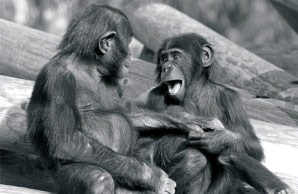
Working with chimps, De Waal and others have observed behavioral synchronization, which indicates what psychologists call “bodily empathy” – like us, chimps tend to yawn when they see another doing so; like ours, their laughter is contagious. Through mood contagion we, our primate ancestors, and many other animals are able to coordinate group behavior – a fact that is not lost on modern dictators and politicians. But do chimps and bonobos exhibit real empathy – empathy that does not indicate a potential reward?
Writes de Waal, “When a bonobo named Kuni saw a starling hit the glass of her enclosure at the Twycross Zoo in Great Britain, she went to comfort it. Picking up the stunned bird, Kuni gently set it on its feet. When it failed to move, she threw it a little, but the bird just fluttered. With the starling in hand, Kuni then climbed to the top of the tallest tree, wrapping her legs around the trunk so that she had both hands free to hold the bird. She carefully unfolded its wings and spread them wide, holding one wing between the fingers of each hand, before sending the bird like a little toy airplane out toward the barrier of her enclosure. But the bird fell short of freedom and landed on the bank of the moat. Kuni climbed down and stood watch over the starling for a long time, protecting it against a curious juvenile. By the end of the day, the recovered bird had flown off safely.”
It is evident that our closest remaining ape ancestors evolved with the building blocks of our human abilities which may also have existed in our common ancestor Pan.
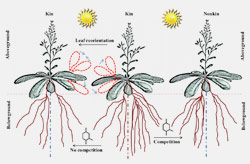
Early Signs of Cooperation
The evolutionary origins and advantages of kin or group recognition are found even in plant life. Plants compete for space and nutrient and a particular species will be more aggressive in producing and allocating roots to sequester nutrients when situated in kin–nonkin conditions, compared with kin–kin situations. For example, in 2007 Susan Dudley of McMaster University in Ontario, Canada showed that a beach weed called sea rocket senses whether it’s growing among siblings or unrelated plants of the same species. When it detects strangers, it allocates more resources toward sprouting nutrient-grabbing roots than when it recognizes kin. Some plants like ragweed grown among kin develop larger common mycelial networks—through which plants and fungi trade nutrients—than those grown among non-kin, and with increased root colonization are better protected against pathogens. Crepy & Casal show that plants recognized their kin neighbors by horizontally reorienting leaf growth more often when compared with the interactions with the nonkin members. By interacting with kin they showed that plants yielded more seeds compared with those interacting with non-kin members, a process described by New Phytologist as “a clear indication of mutual benefit and cooperation.”

The Age of Empathy and The Bonobo and the Atheist
Frans de Waal
Both reciprocity and empathy – the two pillars upon which morality is built – are found in bonobos, apes and other social animals. But only humans are able to “abstract” the value and extend the behavioral constraints of “one-on-one” morality to the larger society, including strangers.
In the series: Our Nearest Relatives
Related articles:
- Genetics and Human Evolution
- She Has Her Mother's Laugh
- Neanderthal Man – In Search of Lost Genomes
- Our Nearest Relatives: Bonobos and Chimpanzees
- Our Hominid Predecessors
- Human Universals
- The Evolution of Human Morality: The Age of Empathy and The Bonobo and the Atheist
- The Gap: The Science of What Separates Us from Other Animals
- Before the Dawn: New details of human evolution revealed
Further Reading
External Stories and Videos
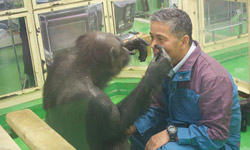
Chimps Are Making Monkeys Out of Us
Justin McCurry, The Guardian
Extraordinary research from Japan shows that chimpanzees are way ahead of humans in complex memory tests.
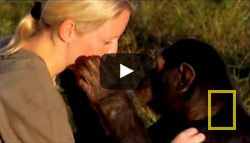

Watch: Self-Recognition in Apes
National Geographic
Researchers set up tests to show that great apes can recognize themselves in the mirror.


